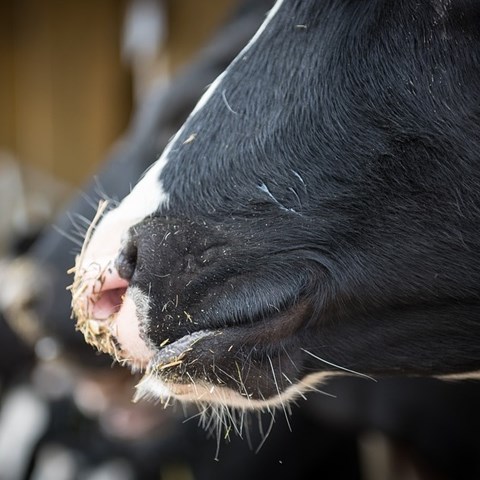Contact
Department of Anatomy, Physiology and Biochemistry (AFB), Division of Anatomy and Physiology

The effects of a grain-based subacute ruminal acidosis (SARA) challenge on bacteria in the rumen and feces of lactating dairy cows were determined. Six lactating, rumen-cannulated Danish Holstein cows were used in a cross-over study with two periods. Periods included two cows on a control diet and two cows on a SARA challenge. The control diet was a total mixed ration containing 45.5% dry matter (DM), 43.8% DM neutral detergent fiber, and 19.6% DM starch.
The SARA challenge was conducted by gradually substituting the control diet with pellets containing 50% wheat and 50% barley over 3 days to reach a diet containing 55.6% DM, 31.3% DM neutral detergent fiber, and 31.8% DM starch, which was fed for four more days. Rumen fluid samples were collected at day 7 and 10 of experimental periods. Feces samples were collected on days 8 and 10 of these periods. Extracted DNA from the rumen and feces samples was analyzed to assess their bacterial communities using MiSeq Illumina sequencing of the V4 region of the 16S rRNA gene.
The induction of SARA reduced the richness, diversity, and stability of bacterial communities and resulted in distinctly different microbiota in the rumen and feces. Bacteroidetes and Firmicutes were the most abundant phyla and, combined, they represented 76.9 and 94.4% of the bacterial community in the rumen fluid and the feces, respectively. Only the relative abundance of Firmicutes in the rumen was increased by the SARA challenge. In rumen fluid and feces, the abundances of nine out of the 90 and 25 out of the 89 taxa, respectively, were affected by the challenge.
Hence, SARA challenge altered the composition of the bacterial community at the lower taxonomical level in the feces and therefore also likely in the hindgut, as well as in the rumen. However, only reductions in the bacterial richness and diversity in the rumen fluid and feces were in agreement with those of other studies and had a biological basis. Although the composition of the bacterial community of the feces was affected by the SARA challenge, bacterial taxa in the feces that can be used for accurate and non-invasive diagnosis of SARA could not be identified.
https://doi.org/10.1007/s00248-017-0940-z
Plaizier, J.C., Li, S., Danscher, A.M. et al. Changes in Microbiota in Rumen Digesta and Feces Due to a Grain-Based Subacute Ruminal Acidosis (SARA) Challenge. Microb Ecol (2017) 74: 485-495.